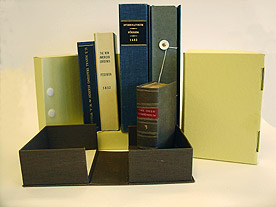
Storage Enclosures
1 Types of Enclosures | 2 Custom vs. Standard Enclosures
As with storage furniture, low-quality enclosures can damage collections both physically and chemically. Chemical damage such as yellowing, discoloration, or embrittlement can result from direct contact with acids produced by poor-quality storage materials, and physical damage can result when enclosures of inadequate size or shape (or no enclosures at all) are used.
It is important to understand the terminology used to describe preservation storage enclosures, and to be aware of which enclosures are appropriate for which collections. What do the terms "archival quality" and "acid-free" mean? What types of enclosures are appropriate for documents, for photographs, and/or for oversize materials? These basic concepts will be covered in this section.
1 Types of Enclosures
While all enclosures deteriorate over time, those made from acidic paper or board can damage the collections they are meant to protect relatively quickly. Many enclosures can cause damage because they are the wrong size and do not provide proper support. In addition, fasteners, attachments, and inserts (e.g., paper clips, pins, rubber bands, bookmarks, newspaper clippings, Post-it Notes, etc.) can stain and tear paper collections. Poor-quality enclosures and older preservation-quality enclosures can be tested with a pH pen, available from conservation suppliers, to determine whether they are acidic or alkaline.
Storage enclosures for books and flat paper should be made of materials which are durable (strong) and chemically stable (permanent). They should fit the item(s) properly and provide good support. "Archival" and "acid-free" are two terms that you will frequently encounter. There are no standards governing the use of these terms, and they are sometimes misused, so read suppliers' catalogs carefully. If there are questions about a product, ask the supplier for details. If that information is not forthcoming, find another supplier.
Terminology
The term "pH" is used to express the acidity or alkalinity of paper-based materials. It does not apply to plastics. The pH scale runs from zero to 14, with 7 being neutral, below 7 being acidic, and above 7 being alkaline.
- Acid-free or acid-neutral enclosures have a pH of 7 to 7.5 and will absorb a limited amount of acid before they themselves become acidic and begin to decay.
- Lignin-free or low-lignin paper is produced from cotton or linen or other materials from which the lignin, a natural component of wood that darkens when exposed to light, has been chemically removed.
- Buffered or alkaline-buffered enclosures contain an alkaline substance (the buffer) to raise the pH of the paper so it can absorb and/or neutralize a certain amount of acid.
Lignin-free, buffered enclosures (pH 8.5 or above) actively reduce the sources of acid damage and are preferred for most paper-based materials.
PAT Test
The Photographic Activity Test (PAT) was developed by the Image Permanence Institute (IPI) to evaluate the suitability of enclosures for photographic materials. The PAT can be performed on paper or plastic enclosures. It indicates whether the enclosures contain harmful chemicals that will cause image fading or staining. Enclosures used for photographic materials must pass the PAT (this should be noted in the supplier catalog); those that pass would be appropriate for other types of archival materials as well.
Plastic Enclosures
Plastics used for storage enclosures vary greatly in chemical stability. Those made of polyester, polypropylene, and polyethylene are generally safe to use for storing paper and photograph collections. Plastic enclosures should be free of plasticizers, surface coatings, UV inhibitors, and other materials that may interact with collections. Plastic sleeves can allow both sides of an item to be viewed without touching the original, and they provide additional support during handling. Evidence has shown, however, that storage in plastic can accelerate deterioration by trapping acidic byproducts of decay. Never use plastic enclosures if the media is flaking or friable, as with charcoal or soft pencil. The choice of paper vs. plastic enclosures may ultimately be a compromise between protection against handling and protection against chemical damage.
2 Custom vs. Standard Enclosures
|
|
Standard-size enclosures from conservation suppliers will normally be sufficient to provide support and protection for collections, but sometimes custom-made enclosures are needed. Conservation suppliers are generally willing to work with you to produce enclosures for a specialized need.
The most frequently encountered custom enclosures are book boxes. These can be made by a conservator or by bookbinding companies. They are generally used for books of significant value to avoid abrasion from the book shifting inside a box that is too large, or damage to the book's joints and edges by a box that is too small.
Large and varied collections require a variety of enclosures to house artifacts as well as bound materials. View the video "Boxing Our Treasures" from the National Archives to see how specialists construct custom boxes for items as varied as a Cold War-era pistol and a 1761 Indian treaty.

